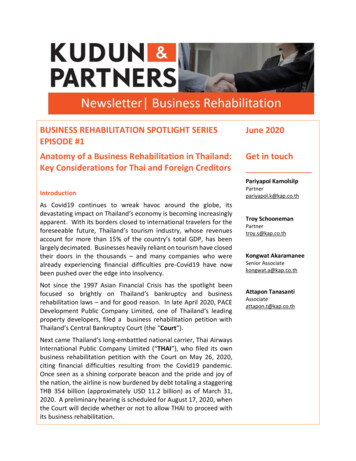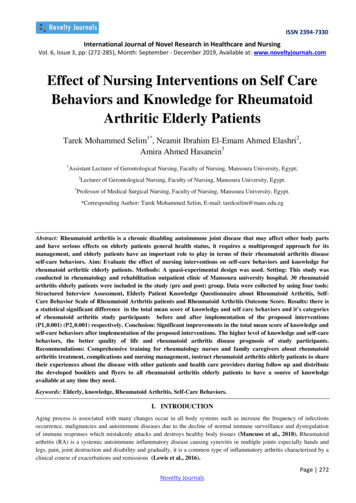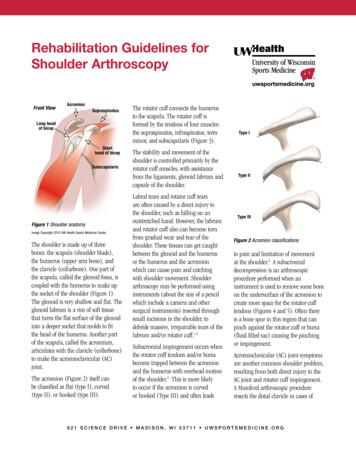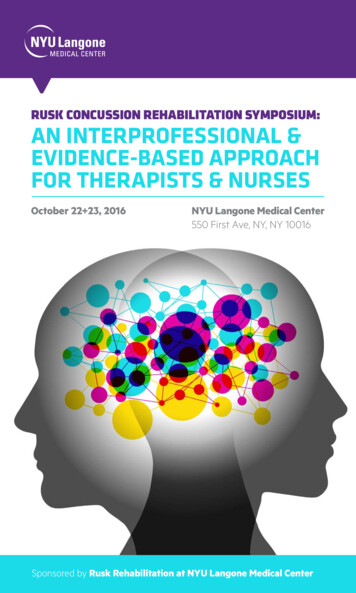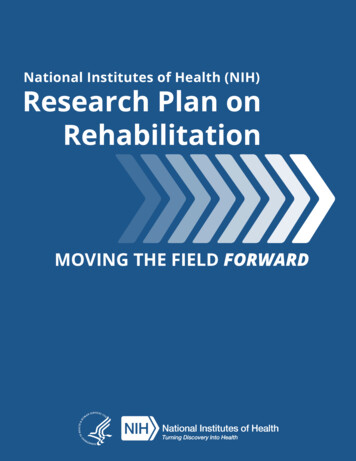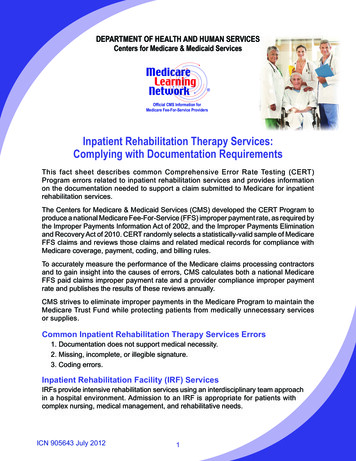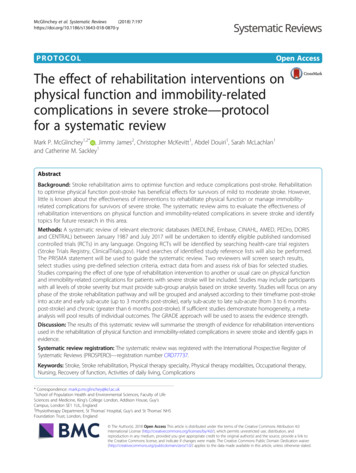
Transcription
McGlinchey et al. Systematic Reviews(2018) OCOLOpen AccessThe effect of rehabilitation interventions onphysical function and immobility-relatedcomplications in severe stroke—protocolfor a systematic reviewMark P. McGlinchey1,2* , Jimmy James2, Christopher McKevitt1, Abdel Douiri1, Sarah McLachlan1and Catherine M. Sackley1AbstractBackground: Stroke rehabilitation aims to optimise function and reduce complications post-stroke. Rehabilitationto optimise physical function post-stroke has beneficial effects for survivors of mild to moderate stroke. However,little is known about the effectiveness of interventions to rehabilitate physical function or manage immobilityrelated complications for survivors of severe stroke. The systematic review aims to evaluate the effectiveness ofrehabilitation interventions on physical function and immobility-related complications in severe stroke and identifytopics for future research in this area.Methods: A systematic review of relevant electronic databases (MEDLINE, Embase, CINAHL, AMED, PEDro, DORISand CENTRAL) between January 1987 and July 2017 will be undertaken to identify eligible published randomisedcontrolled trials (RCTs) in any language. Ongoing RCTs will be identified by searching health-care trial registers(Stroke Trials Registry, ClinicalTrials.gov). Hand searches of identified study reference lists will also be performed.The PRISMA statement will be used to guide the systematic review. Two reviewers will screen search results,select studies using pre-defined selection criteria, extract data from and assess risk of bias for selected studies.Studies comparing the effect of one type of rehabilitation intervention to another or usual care on physical functionand immobility-related complications for patients with severe stroke will be included. Studies may include participantswith all levels of stroke severity but must provide sub-group analysis based on stroke severity. Studies will focus on anyphase of the stroke rehabilitation pathway and will be grouped and analysed according to their timeframe post-strokeinto acute and early sub-acute (up to 3 months post-stroke), early sub-acute to late sub-acute (from 3 to 6 monthspost-stroke) and chronic (greater than 6 months post-stroke). If sufficient studies demonstrate homogeneity, a metaanalysis will pool results of individual outcomes. The GRADE approach will be used to assess the evidence strength.Discussion: The results of this systematic review will summarise the strength of evidence for rehabilitation interventionsused in the rehabilitation of physical function and immobility-related complications in severe stroke and identify gaps inevidence.Systematic review registration: The systematic review was registered with the International Prospective Register ofSystematic Reviews (PROSPERO)—registration number CRD77737.Keywords: Stroke, Stroke rehabilitation, Physical therapy speciality, Physical therapy modalities, Occupational therapy,Nursing, Recovery of function, Activities of daily living, Complications* Correspondence: mark.p.mcglinchey@kcl.ac.uk1School of Population Health and Environmental Sciences, Faculty of LifeSciences and Medicine, King’s College London, Addison House, Guy’sCampus, London SE1 1UL, England2Physiotherapy Department, St Thomas’ Hospital, Guy’s and St Thomas’ NHSFoundation Trust, London, England The Author(s). 2018 Open Access This article is distributed under the terms of the Creative Commons Attribution 4.0International License (http://creativecommons.org/licenses/by/4.0/), which permits unrestricted use, distribution, andreproduction in any medium, provided you give appropriate credit to the original author(s) and the source, provide a link tothe Creative Commons license, and indicate if changes were made. The Creative Commons Public Domain Dedication o/1.0/) applies to the data made available in this article, unless otherwise stated.
McGlinchey et al. Systematic Reviews(2018) 7:197BackgroundStroke is the second most common cause of death andthird most common cause of disability globally [1, 2]. In2013, there were 10.3 million new cases of stroke, 6.5 million deaths and 113 million disability adjusted life years(DALYs) attributed to stroke worldwide [3]. The number ofstroke survivors, estimated to be 25.7 million, is expectedto rise over the next few decades primarily due to population growth and ageing [3]. In addition to the considerablenumber of people affected by stroke, stroke has a significanteconomic cost that includes the direct health-care costs totreat stroke, lost productivity and informal care costs [4, 5].One method to manage the sequelae of stroke isstroke rehabilitation, a process that commences soonafter stroke that enables a person to achieve their optimal physical, cognitive, communicative, emotional andsocial level of function [6–8]. Physical function can bedefined as the ability to perform various physical activities and includes functioning of the upper limbs (e.g.grasping objects), lower limbs (e.g. walking), and activities of daily living (e.g. washing, dressing) [9, 10]. Rehabilitation of physical function comprises a largecomponent of stroke rehabilitation programmes delivered by health-care professionals, such as physiotherapists and occupational therapists [11]. Whilst severalsystematic reviews support the use of rehabilitation interventions to improve aspects of physical functionpost-stroke, such as motor function, balance, walkingspeed and activities of daily living [12–14], it is not clearfrom these reviews if these interventions can be provided to stroke survivors with differing levels of strokeseverity, particularly severe stroke.Severe stroke can be understood as a stroke resultingin a significant amount of brain tissue damage and multiple neurological impairments, which leads to a significant loss of function [15]. Dependent upon how it ismeasured, it is estimated that between 14 and 31% ofpeople who sustain a stroke globally have a severe stroke[16–20] and this cohort of the stroke population experience worse outcomes compared to survivors of less severe stroke [21–30]. In the initial hospitalisation phasepost-stroke, they are more likely to develop acute medical complications, which are negatively associated withfunctional recovery [21]. In addition, as many as 40% ofpatients with severe stroke have died by 3 months compared to just under 5% for those patients with mildstroke [22–24]. Survivors of severe stroke spend longerin hospital, which results in increased hospital costs, anddemonstrate slower and less functional recovery, whichresults in greater dependency upon hospital discharge[16, 17, 25–27]. For those who are discharged from hospital alive, severe stroke survivors are at least eight timesmore likely to be discharged to a nursing home [27, 28].Longer-term care costs, which mostly support severePage 2 of 8stroke survivors, represent 49% of total stroke carespending globally [5]. In the first-year post severe stroke,mortality can be as high as 60% [22] and survivors of severe stroke also experience very high levels ofimmobility-related complications, such as falls, contracture, pain, and pressure sores [29, 30]. Due to this residual disability, the physical assistance provided bycaregivers to look after survivors of severe stroke as wellas the psychosocial and emotional impact of the strokeon caregivers result in high levels of caregiver burden[31, 32]. Because of the range of issues faced by survivors of severe stroke, rehabilitation should focus on addressing these poor outcomes, particularly reducedphysical function and its associated complications.However, the extent to which rehabilitation can addressthese outcomes is not clear. As most studies investigatingthe efficacy of specific rehabilitation interventions onphysical function included stroke survivors with mild tomoderate levels of stroke severity [12–14], it is not knownif research findings are applicable to survivors of severestroke, who have very different clinical presentations compared to survivors of less severe stroke. It is not clearwhether rehabilitation should focus more on the restoration of function, which may not always be possible or isoften incomplete, or more on reducing immobility-relatedcomplications, which may reduce the longer term burdenfor caregivers of severe stroke survivors. Due to the lackof clarity in the literature regarding the optimal rehabilitation management for survivors of severe stroke, there isan urgent need to summarise evidence-based rehabilitation interventions designed to optimise physical functionand reduce immobility-related complications for this cohort of the stroke population.AimsThis systematic review aims to: Establish the effectiveness of rehabilitationinterventions on physical function and immobilityrelated complications for survivors of severe stroke. Identify questions for future rehabilitation researchfor survivors of severe stroke.MethodsThe systematic review will be conducted in accordancewith the Preferred Reporting Items for SystematicReviews and Meta-analyses (PRISMA) statement [33].The protocol was registered with the International Prospective Register of Systematic Reviews (PROSPERO) onSeptember 22, 2017 (registration number CRD477737)[34]. The protocol has been reported according to thePreferred Reporting Items for Systematic Reviews andMeta-analysis Protocols (PRISMA-P) 2015 checklist (seeAdditional file 1).
McGlinchey et al. Systematic Reviews(2018) 7:197Eligibility criteriaStudies will be selected according to the eligibility criteriabelow and in Table 1, which are based upon the PICO (participant, intervention, comparator and outcome) format.ParticipantsThe review will include studies of adult stroke patients,defined as 18 years of age. As the review is investigating the effectiveness of rehabilitation interventions in severe stroke, studies may include patients with all levelsof stroke severity but must include sub-group analysisbased on stroke severity. Stroke severity will be definedusing a score on either a validated and routinely usedstroke specific health measure, e.g. National Institutes ofHealth Stroke Scale (NIHSS), Orpington PrognosticScale (OPS); functional measure, e.g. Functional Independence Measure (FIM), Barthel Index (BI); or disability measure, e.g. Modified Rankin Scale (mRS) [35–39].Whilst some measures, such as the OPS or mRS, use thesame pre-defined cutoff scores to determine stroke severity [32, 35], other outcome measures, such as theNIHSS, BI or FIM, do not have as clearly defined cutoffscores to determine stroke severity. For the purposes ofthis review, an NIHSS score 16, BI score 45 (modifiedBI 9) and FIM score 40 will be indicative of a severestroke [16, 17, 40–44]. The mean/median severity scoresand standard deviation/interquartile range of a study’sPage 3 of 8patient cohort must fall within the severe stroke category to be included in the study.InterventionsThe review will include studies that involve theprovision of rehabilitation interventions used to manageproblems relating to physical function or immobility-related complications post-stroke. For the purposes of thereview, a rehabilitation intervention will be defined asany non-surgical or non-pharmacological interventionused in current clinical practice as part of the usual rehabilitative care of stroke patients. These interventionsmay be delivered by rehabilitation staff (e.g. physiotherapists, occupational therapists, nurses) or by people whohave received training by rehabilitation staff, such aspaid or unpaid carers of stroke survivors. It will notinclude interventions that primarily address problemsrelated to cognitive, communicative or swallowing dysfunction post severe stroke. The list of interventionscovered by the systematic review is in Table 1. The review will include studies of rehabilitation interventionsthat are provided in any phase of the post-stroke pathway and in any physical or geographical location. Thereview will note whether the authors have used a recognised framework to describe the intervention, such asthe Template for Intervention Description and Replication (TIDier) checklist and guide [45].Table 1 Eligibility criteria for screened referencesStudy designRandomised controlled trial (controlled trial)Report characteristicsFull articlePublication date January 1987 to July 2017ParticipantsAdult humans and any of the following: Severe stroke (measured using a recognised stroke-specific health measure, disability measure, functional measure) Stroke with stroke severity subsets reported (at least 2 subsets with 1 subset identified as severe stroke)InterventionsAny of the following: Passive intervention (e.g. positioning, stretching programme, manual technique)Active rehabilitation task (e.g. active or strengthening exercise, functional task practice)Adjunctive therapies (e.g. electrical stimulation, treadmill training, robotics)Aid or equipment (e.g. splint, wheelchair)Environmental adaptationTraining and education (to carers or other health-care professionals)Provided by any of the following: Physiotherapist, occupational therapist, nurse Support or assistant staff of the above professions Paid or unpaid carerComparatorAny of the following: Any rehabilitation intervention No intervention Usual careOutcomesAny of the following: Measure of body function, activity or participation Immobility-related complication (any of the following): contracture, pressure sore, spasticity, chest infection, urinary tractinfection, deep vein thrombosis, pulmonary embolism, fall, pain, shoulder pain, fatigue, depressionInclude outcomes measured by direct observation by health-care professionals as well as proxy reports by carers/patients
McGlinchey et al. Systematic Reviews(2018) 7:197ComparatorsThe review will include studies that have a comparator.The comparator will be any of the following: anothertype of rehabilitation intervention, usual care or nointervention. Usual care may be defined as the rehabilitation that the patient would normally receive as part ofundergoing stroke rehabilitation.OutcomesThe review will include studies that focus on the primary outcomes of physical function and post-strokecomplications. As function can be defined according tobody function, activities and participation [10], physicalfunction will be assessed using measures of body function, e.g. Fugl-Meyer Assessment, Motricity Index,Modified Ashworth Scale; activity, e.g. BI, FIM, MotorAssessment Scale; and participation, e.g. Stroke ImpactScale [46–48]. An immobility-related complication maybe defined as any medical problem arising after a strokebecause of immobility or reduced physical activity [49].These complications are listed in Table 1. The reviewwill also note whether studies have included an economic evaluation.Study designAs the review will compare the effectiveness of one typeof rehabilitation intervention to another, to usual care orno intervention, it will include studies where participantshave been randomly allocated to one of two or moretreatment groups. Therefore, it will include randomisedcontrolled trials (RCTs) as the primary study design. Ifthere are no RCTs that meet the eligibility criteria,quasi-experimental or non-randomised controlled trialswill be considered for inclusion. However, the ability toestablish the effectiveness of a physical rehabilitationintervention may be reduced with this type of study design and this will be specifically highlighted when reporting the results of the systematic review.Page 4 of 8Physiotherapy Evidence Database (PEDro), Database ofResearch in Stroke (DORIS) and the Cochrane CentralRegister of Controlled Trials (CENTRAL). Databaseswill be searched from January 1987 to July 2017. Published abstracts from relevant stroke conferences (e.g.ESO, UKSF, SRR) will also be searched from January1987 to July 2017. Ongoing studies will be identified bysearching the Stroke Trials Registry (www.strokecenter.org/trials/) and ClinicalTrials.gov. These sources will besearched from 2012 to 2017 as it will be assumed thatstudies before these dates will have been completed andpublished. References from included studies will be handsearched and any potentially relevant study will be included for review. Forward citation checks of includedstudies will also be performed.SearchA search strategy has been developed that focuses onthe following key search terms: severe stroke and strokedisability, stroke rehabilitation and physical rehabilitation (including individual interventions listed in Table 1),physiotherapy/physical therapy, occupational therapy,nursing care, functional recovery, physical function, activities of daily living and immobility-related complications (including individual complications listed inTable 1). Search terms have been established by scopingsearches using Medical Subject Headings (MeSH). TheMEDLINE search strategy is detailed in Appendix. Thissearch will be adapted for the other databases.Data managementThe results from the literature search will be uploadedto a reference management programme (Refworks). Duplicate references will be identified using the management programme and removed. A final list ofnon-duplicated references will be generated by one author (MM).Study selectionReport characteristicsIn order to avoid language or cultural bias, studies inany language or geographical location will be included.Studies not written in English will be translated intoEnglish using university-based translation services. Following a scoping review of the literature which demonstrated very few studies conducted before 2000 and toensure studies reflect current clinical practice, the reviewwill limit the search to 30 years (1987 to 2017).The titles and abstracts of the search results will bescreened, and full text will be obtained for relevant studies. Two review authors (MM and JJ) will complete thisprocess manually and independently, and any differencein opinion will be resolved by a third review author(CS). Full-text articles will be reviewed to determine ifstudies included through screening meet the inclusioncriteria. An inclusion/exclusion checklist has been developed based on the eligibility criteria. Two review authors(MM and JJ) have piloted the checklist (Table 1).Information sourcesElectronic searches of the following databases will beconducted: MEDLINE, Embase, Cumulative Index toNursing and Allied Health Literature (CINAHL), Alliedand Complementary Medicine Database (AMED),Data collection process and data itemsTwo review authors (MM and JJ) will independently perform data extraction for all eligible papers identifiedthrough the screening process. A data extraction proforma
McGlinchey et al. Systematic Reviews(2018) 7:197Page 5 of 8Risk of bias of included studies will be performed by tworeview authors independently (MM and JJ). Informationwill be collected using the Cochrane Collaboration toolfor assessing the risk of bias which focuses on sequencegeneration, allocation concealment, blinding, incompleteoutcome data and selective outcome reporting [50]. Anoverall score will not be generated but a risk of biasjudgement of ‘high’, ‘low’ or ‘unclear’ will be given for individual domains. Any difference in opinion will be resolved by a third review author (CS). The studies’ risk ofbias will be presented in a table, and a narrative summary will be produced. Based on the assessment of riskof bias, a sensitivity analysis excluding studies with ahigh risk of bias will be performed.among studies, if observed, will be investigated. RevManwill be used as the meta-analysis software. Data from dichotomous outcomes, e.g. post-stroke complications willbe analysed using risk ratio with 95% confidence interval. Data from standardised outcome measures of motorfunction and functional recovery will be treated as continuous data and will be analysed using mean differenceswith 95% confidence intervals. If studies demonstratesubstantial differences in terms of data collected or onlya few studies are found, a qualitative review of resultswill be performed. This will include a summary of studydesign, sample size, participant characteristics, outcomesand results. As there may be differences in recoveryrates and outcomes according to the time post-stroke, asub-group analysis will be conducted to explore the effects of time post-stroke. Studies will be grouped intothree timeframes determined on the basis of when patients are recruited to the study: acute and earlysub-acute (up to 3 months post-stroke), early sub-acute tolate sub-acute (from 3 to 6 months post-stroke) and chronic(greater than 6 months post-stroke). These timeframes havebeen chosen based on recommendations for the standardised measurement of sensorimotor recovery in stroke trials[52].Data synthesis and analysisQuality of the evidenceIf more than five adequately powered studies demonstrate homogeneity across studies in terms of rehabilitation interventions and outcomes, results for individualoutcomes will be pooled quantitatively using both metaanalysis with fixed and random effect models and interpreted as appropriate. Possible sources of heterogeneityAssessment of the strength of the evidence will be performed using the Grading of Recommendations Assessment, Development and Evaluation (GRADE) approach[50]. The five domains considered by the GRADE approach include risk of bias, inconsistencies betweenstudies, indirectness, imprecision and publication bias.has been developed based on the Cochrane handbook forsystematic reviews of interventions and the CONSORTstatement for reporting randomised trials [50, 51]. Theform focuses on study design and methods, participants,intervention details, outcome measures used, and results(Table 2). The form has been piloted independently by thelead author (MM). A Microsoft Excel document will beused to manage the data extraction.Risk of biasTable 2 Data extraction form checklistSource Reviewer name Review date Study title and authors Journal name Publication dateEligibility Confirm eligibility for reviewIntroduction Scientific background Study aims and hypotheses includedMethods—participants Setting Eligibility criteria Stroke severity measure Method of recruitmentMethods—design and group allocation Study design and duration Group description Sequence generation Allocation concealment Implementation BlindingMethods- Interventions Description of intervention Intervention details (timing, frequency, duration) Resource requirements Use of TIDier checklist—yes/noMethods—outcomes Name and definition Time points measured Measure of function, activity or participation—use of validatedoutcome Immobility-related complication—frequency of occurrence Economic evaluation—yes/noMethods—statistical analyses usedResults Number of participants randomised/allocated per group/analysed Details of any missing participants Baseline demographics for each group Summary data for each group at each time point Compliance with intervention Any adverse eventsDiscussion/conclusion Interpretation of results Extent of generalisability Key conclusions
McGlinchey et al. Systematic Reviews(2018) 7:197The quality of the evidence will be ranked high, medium,low or very low by two review authors independently(MM and JJ).DiscussionAs survivors of severe stroke experience worse outcomescompared to survivors of less severe stroke, it is notclear if rehabilitation interventions designed to managethe residual physical problems for this cohort of thestroke population are effective. The results of this systematic review will summarise the strength of evidencefor interventions used in the rehabilitation of physicalfunction and immobility-related complications in severestroke. If there is no, limited or inconclusive evidencefor any of the identified interventions, the systematic review will identify where further research is required.AppendixMEDLINE search strategy1. exp Stroke/2. severe stroke.mp.3. stroke severit*.mp.4. stroke disabilit*.mp.5. exp Physical Therapy Modalities/6. exp Occupational Therapy/7. exp Nursing Care/8. physical rehabilitation.mp.9. exp Stroke Rehabilitation/10. exp Patient Positioning/11. exp Posture/12. exp Exercise/13. exp Exercise Therapy/14. passive exercise.mp.15. exp “Range of Motion, Articular”/16. manual technique.mp.17. active exercise.mp.18. Resistance Training/19. exp Muscle Stretching Exercises/20. exp Electric Stimulation/21. exp Electric Stimulation Therapy/22. exp Wheelchairs/23. seat?.mp.24. exp “Equipment and Supplies”/25. exp Teaching/26. exp Education/27. exp Motor Skills/28. exp Movement/29. motor function.mp.30. motor recovery.mp.31. exp “Recovery of Function”/32. exp “Activities of Daily Living”/33. functional independence.mp.34. physical independence.mp.Page 6 of 835. complicatio*.mp.36. exp Pain/37. exp Contracture/38. exp Pressure Ulcer/39. exp Respiratory Tract Infections/40. Muscle Spasticity/41. Venous Thrombosis/42. exp Pulmonary Embolism/43. exp Urinary Tract Infections/44. exp Accidental Falls/45. exp Fatigue/46. exp Depression/47. 1 or 2 or 3 or 448. 5 or 6 or 7 or 8 or 9 or 10 or 11 or 12 or 13 or 14or 15 or 16 or 17 or 18 or 19 or 20 or 21 or 22 or23 or 24 or 25 or 2649. 27 or 28 or 29 or 3050. 31 or 32 or 33 or 3451. 35 or 36 or 37 or 38 or 39 or 40 or 41 or 42 or 43or 44 or 45 or 4652. 47 and 48 and 4953. 47 and 48 and 5054. 47 and 48 and 5155. limit 52 to (“all adult (19 plus years)” andrandomized controlled trial)56. limit 53 to (“all adult (19 plus years)” andrandomized controlled trial)57. limit 54 to (“all adult (19 plus years)” andrandomized controlled trial)Additional fileAdditional file 1: Prisma-P checklist. (DOCX 33 kb)AbbreviationsAMED: Allied and Complementary Medicine Database; BI: Barthel Index;CENTRAL: Cochrane Central Register of Controlled Trials; CINAHL: CumulativeIndex to Nursing and Allied Health Literature; DORIS: Database of Research inStroke; FIM: Functional Independence Measure; GRADE: Grading ofRecommendations Assessment, Development and Evaluation; mRS: ModifiedRankin Scale; NIHSS: National Institutes of Health Stroke Scale;OPS: Orpington Prognostic Scale; PEDro: Physiotherapy Evidence Database;PRISMA: Preferred Reporting Items for Systematic Reviews and Meta-analyses;TIDier: Template for Intervention Description and ReplicationAcknowledgementsThis project is sponsored by King’s College London and has overall controlof the design, conduct, analysis, interpretation and dissemination of thesystematic review. The authors would like to thank Claire Simcox forproviding feedback on the data extraction form.FundingThis project forms part of MM’s PhD which is funded by The Dunhill MedicalTrust [grant number RT62/0116]. The funder has had no input on the designof the protocol and will have no input on the analysis and interpretation ofthe results of the systematic review, or publication of the systematic review.Availability of data and materialsNot applicable
McGlinchey et al. Systematic Reviews(2018) 7:197Authors’ contributionsMM is the guarantor of the review. MM, CS and CM were involved in thedesign of the protocol and systematic review. MM conducted the scopingsearches. MM and JJ piloted the inclusion/exclusion form. MM and SMpiloted the data extraction form. MM will be first reviewer, and JJ will be thesecond reviewer for the systematic review. AD provided statistical supportfor the systematic review. MM drafted the manuscript. All authors read andapproved the final manuscript.Page 7 of 815.16.17.Ethics approval and consent to participateNot applicable18.Consent for publicationNot applicableCompeting interestsThe authors declare that they have no competing interests.19.Publisher’s Note20.Springer Nature remains neutral with regard to jurisdictional claims inpublished maps and institutional affiliations.21.Received: 5 May 2018 Accepted: 2 November 2018References1. GBD 2016 Causes of Death Collaborators. Global, regional, and national agesex specific mortality for 264 causes of death, 1980–2016: a systematicanalysis for the Global Burden of Disease Study 2016. Lancet. 2017;390:1151–210.2. GBD 2016 DALYs and HALE Collaborators. Global, regional, and nationaldisability-adjusted life-years (DALYs) for 333 diseases and injuries andhealthy life expectancy (HALE) for 195 countries and territories, 1990–2016:a systematic analysis for the Global Burden of Disease Study 2016. Lancet.2017;390:1260–344.3. Feigen VL, Norrving B, Mensah GA. Global burden of stroke. Circ Res. 2017;120:439–48.4. Evers SM, Struijs JN, Ament AJ, van Genugten ML, Jager JH, Van DenBos GAM. International comparison of stroke cost studies. Stroke. 2004;35:1209–15.5. Patel A, Berdunov V, King D, Quayyum Z, Wittenberg R, Knapp M. Current,future and avoidable costs of stroke in the UK: executive summary part 2:Stroke Association; 2017. sof stroke in the uk report -executive summary part 2.pdf. Accessed 20Apr 20186. National Institute for Health and Care Excellence. Stroke rehabilitation. Longterm rehabilitation after stroke. 2013. NICE guideline (CG 162).7. Hebert D, Lindsay MP, McIntyre A, Kirton A, Rumney PG, Bag S. Canadianstroke best practice recommendations: stroke rehabilitation practiceguidelines, update 2015. Int J Stroke. 2016;11(4):459–84.8. Langhorne P, Bernhardt J, Kwakkel G. Stroke rehabilitation. Lancet. 2011;377:1693–702.9. Patient-Reported Outcome Measurement Information System (PROMIS).PROMIS Network. ystems/promis. Accessed 20 Apr 2018.10. World Health Organization. The ICF- An Overview. 2001. https://www.cdc.gov/nchs/data/icd/icfoverview finalforwho10sept.pdf. Accessed 20Apr 2018.11. De Wit L, Putman K, Lincoln N, Baert I, Berman P, Beyens H, et al. Stro
Background: Stroke rehabilitation aims to optimise function and reduce complications post-stroke. Rehabilitation to optimise physical function post-stroke has beneficial effects for survivors of mild to moderate stroke. However, little is known about the effectiveness of interventions to rehabilitate



